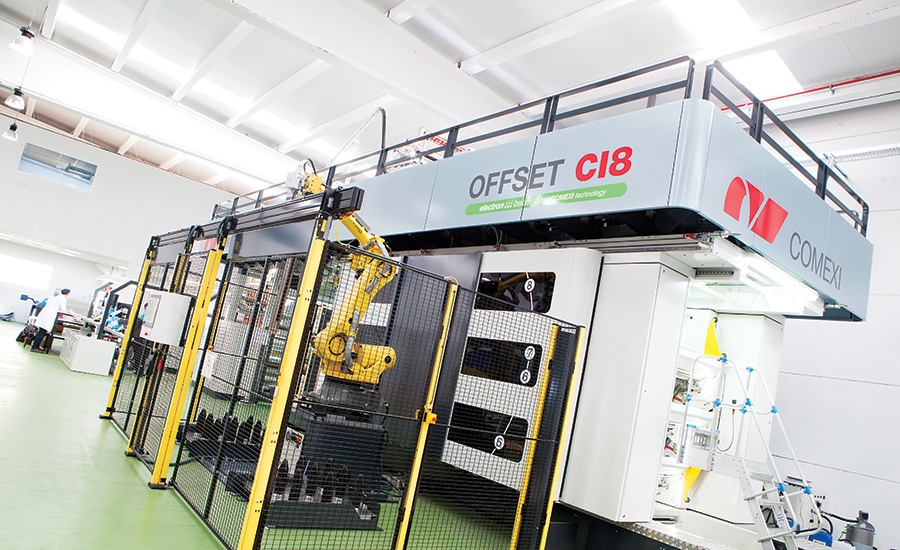EB Technology Helps Advance Offset Printing
EB Technology Helps Advance Offset Printing
Written by Brian Sullivan and Alejandro Teodoro.
Originally posted in FlexPackMag.com
The Comexi OFFSET CI-8 is a variable format press with a central impression drum, specifically designed for printing on extensible materials. It’s a ground-breaking solution that responds to the challenges of the flexible packaging printing sector: reducing environmental impact, increasing energy efficiency, producing high-quality print, and speed to market.
The solution combines the advantages of both offset variable repeats and central impression drum flexo printing in one single press for flexible packaging and labels. It is a combination that exceeds the performance of conventional inline offset machines, because of its ability to easily print thinner, extensible materials (OPP, PET, PE, etc.). The central impression drum design is the key to enable printing stability and control of the register between print units.
The printing units are designed to work with electron beam (EB) curable inks. Contrary to solvent-based ink technology, which is the most widely used technology in flexo and gravure printing, EB inks do not require any solvents. As a result, no dryers, solvent recovery, or incineration are required. This means a significant reduction in energy consumption and carbon footprint. Furthermore, there is no risk of heat negatively affecting the press or substrate.
Over the last several years, the evolution of EB technology has resulted in significant growth in food packaging. Improvements in EB technology have allowed access to packaging applications with demanding food compliance requirements. This is important since the food segment represents 75 percent of the flexible packaging sector.
EB technology has come a long way. Today’s electron beams are smaller, faster, and less expensive than ever before. For many web offset printing applications, voltages in the 90-110kV (kilovolt) range can be used. This is because the offset ink and coatings are so thin, usually less than 5-7 microns thick.
Using less voltage allows for shrinking the overall size of the EB unit. One EB unit, which has an effective drying length of only about 8-10 inches and an overall web path through the machine of fewer than 6 feet, can allow a press to run 400 meters/min and achieve complete cure instantaneously, with very little heat. Conversely, most 8-color CI flexographic presses require eight interstation dryers as well as an end-of-press dryer to dry the solvent-based inks.
The Comexi OFFSET CI8 offers a high and standardized print quality due to its very fine screens (over 80 L/cm) and is capable of printing highlights down to 2 percent coverage. Smooth fading screens and the widest variety of different screen types is another attribute of the CI8.
Offset technology provides maximum flexibility in the production process, allowing a very short time to market due to the fast in-house prepress that enables users to prepare a new job while the press is still carrying out a previous one.
The printing cylinders can be easily exchanged manually (automatic cylinder exchange is available as an option), and all job parameters can be digitally stored and recalled. The pre-setting of mechanical adjustments like ink keys, form-rollers, and printing cylinders are automatic.
Another point to consider is the savings from fast and efficient in-house plate making. Offset technology is characterized by the use of lithographic plates, which cost far less than photopolymer plates or engraved cylinders used in traditional flexo and rotogravure technologies. This capability allows the printer to change design, text, add new logos, make promotional campaigns without additional printing costs, as well as reducing the minimum print runs and print film in stock.
Easy, fast, and low-cost plate making and mounting are some of the many advantages of offset printing. Imaging of the plate takes only 4 minutes, and the price of the plate is extremely low compared to other printing technologies like gravure and flexo.
What Comexi Group offers with central impression offset is a press that has fast job changeover, offers a cleaner printing process, is less expensive to operate, and eliminates the need for solvent inks for short and medium runs. Let’s not forget offset’s time-tested print quality that exceeds rotogravure. ESI EB provides a single cost-effective end-of-press dryer that has the smallest footprint, in addition to the highest uptime and reliability with the lowest operating cost.
ESI
(978) 694-9000
www.ebeam.com
Comexi
(34) 972 47 77 44
www.comexi.com

